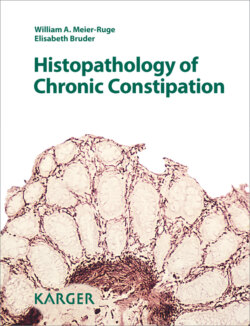Читать книгу Histopathology of Chronic Constipation - W.A. Meier-Ruge - Страница 5
На сайте Литреса книга снята с продажи.
Foreword
ОглавлениеIn 2005, the Journal of Pathobiology (vol. 72) published a review about the pathohistology of motility disorders of the gut. This publication about the morphology of chronic constipation had a remarkable echo. Now, 7 years later, it seemed to be the time to write an update so as to incorporate the new data which has become available since that review. This book represents more than 40 years of experience in rectocolic biopsy diagnostics of gut motility disorders. Pathologists will find much diagnostic information in the field of chronic constipation, often considered as a functional disease without a morphological substrate.
It became obvious that not only an aganglionosis (Hirschsprung’s disease), but also a lack or atrophy of the tendinous collagen net in circular and longitudinal muscles may cause an aperistaltic syndrome.
Enzyme histochemistry has proven to be the pathophysiological technique of choice in the pathology of chronic constipation. This method provides insights into gastrointestinal motility disorders by the cholinergic nervous system and the dehydrogenase activity of nerve cells in the submucous and myenteric plexus. The dehydrogenases of the citric circle selectively stain nerve cells in the intestinal wall. Nitroxide synthase helps the pathologist in immediate sections for microscopic examination under surgery to reliably inform the pediatric surgeon whether the planned resection margin is aganglionic, hypoganglionic, or normal innervated.
Enzyme histochemistry overcomes the often frustrating results of classical histological stainings in formalin-fixed biopsies. Besides classical Hirschsprung’s disease, it is also possible to differentiate in mucosal biopsies ultrashort Hirschsprung’s disease, immaturity of the enteric nervous system, and neuronal dysplasia.
A laboratory guide provides instructions on how to prepare colorectal biopsies or surgical specimens, and how to transport them to the histopathological laboratory over long distances. The most important enzyme histochemical reactions in the diagnosis of gastrointestinal biopsies are also described. A final section briefly outlines immunohistochemical techniques in paraffin sections of formalin-fixed tissue. Immunohistochemistry is a static staining technique like any other histological staining (e.g. hemalum-eosin staining). It is less reliable than the enzyme histochemical technique.
It is the hope of the authors that the technical advice and the many pictures of characteristic anomalies in the gut may be helpful in the understanding and diagnosis of the different intestinal diseases which cause chronic constipation.
